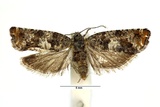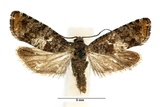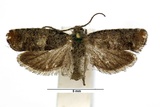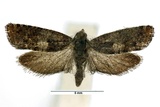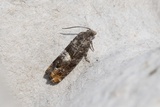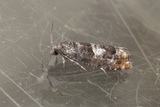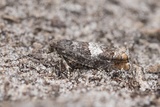Epinotia rubiginosana (Herrich-Schäffer, [1851]) Species
Last modified: Nov. 24, 2025, 1:33 p.m.
An uncommon species in Belgium, except in the Kempen where it is fairly common.
Details
- Classification
- Family: Tortricidae > Subfamily: Olethreutinae > Tribus: Eucosmini > Genus: Epinotia > Species: Epinotia rubiginosana
- Vernacular names
- Dennenoogbladroller (NL), Pine Bell, Pine Tortrix (EN), Großer Kiefernnadelwickler (DE)
- First mention in Belgium
- Thirot E. 1898. Assemblée mensuelle du 3 décembre 1898. — Annales de la Société Entomologique de Belgique 42: 501–503. On page 502.
- Status
-
Native
Distribution
Imago
Wingspan 13–15 mm. Grey forewing with a well defined white subquadrate dorsal blotch which extends more diffusely to the costa as a median fascia, terminal area ferruginous-brown with a weak ocellus of 3 or 4 black streaks that may coalesce to form an ill-defined blackish blotch, proximal to the ocellus there is a variable line of white scales and proximal to this there is a more constant dark brown blotch, the grey ground colour is variably irrorate with black and white scales.
Bionomics
The larva constructs a tubular spinning on the food plant. It leaves this habitation to feed on the adjacent needles. Pupation takes place during the spring amongst leaf-litter on the ground.
They fly about the tops of the trees in afternoon sunshine till dusk and later come to light.
Flight periods
The adults usually fly from late April till well into July, occasionally later. Most observations during May.
Observed on
- Host plant (species):
- Pinus sylvestris and Pinus pinea
The larva lives on Pinus sylvestris, Pinus picea and other Pinus sp.
Habitat
It inhabits clearings in pine plantations and also on isolated trees, especially on heathland.
